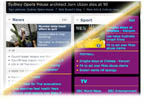Inclusive design in information technologies: The FLUID Project
- hinnovic
- 11 déc. 2008
- 3 min de lecture

Addressing usability issues requires not only a technical solution, but also an understanding of what causes poor user interface design in software development. User experience development is commonly left to programmers, with little to no input from skilled designers, and it is frequently tackled at the end of the development cycle. As a result, components of the user experience are often developed redundantly, inconsistent across applications and inadequately tested and refined.

Hear it!
Click on the above play/pause button to hear this article being "read" to you by a computer. This is another example of what computer operating system developers are integrating into the user interfaces to improve accessibility to personal computers. For more on this, Microsoft Windows™ users can lookup the Narrator functionalities in their user literature. Mac™ users, for their part, should lookup the Speech functionalities.
Accessibility issues in Web applications are also multifaceted; ranging from the inability of assistive technologies to understand the behaviour of the application and its various components, to developers not having the tools and knowledge required to build accessible interfaces.
The Fluid Project has been tackling both the usability and accessibility problem spaces while also looking at the larger problem of usability in open source.
To address these issues, Fluid is creating user interface solutions that improve web applications by making them easier to use in general, and fully accessible in particular. Moreover, these solutions can integrate with existing software. The project is developing a living library of tools for web applications that can be utilized, contributed to, and evolved by the community.
Most application developers are genuinely interested in user experience issues, and they want to create software that people love to use. So Fluid tries to build on that natural enthusiasm, giving communities the tools they need to provide a rich experience for their users. We have seen a positive impact when we worked alongside other projects, and we have learned a lot in the process, too. The outcome is rich, reusable, flexible tools for common tasks users perform in web applications.
Fluid attempts to address usability and accessibility on all levels of the design and development processes. For example, our User Experience Toolkit provides advice on how to build the right interface for a particular context, and offers tools to identify problem areas in a design, as well as low-cost techniques for testing software with end users.

Fluid’s involvement in the global accessibility standards development efforts is also important. We have been working closely with the W3C, Mozilla, and JavaScript toolkit communities to ensure that new Web 2.0 applications are accessible for all. Through our engagement in these communities, we have found that building accessibility into popular web tools has meant less work for developers creating user interfaces. Moreover, building up the knowledge and expertise of the developer community ensures that accessibility and usability are not lost over time but rather refined and improved.
We hope that our customizable approach will encourage others to share their unique adaptations and styles of Fluid components with the community. We also want to see accessibility and usability become standard parts of open source projects and we are working to provide the tools required for this.
One such tool allows users to personalize and transform web application to match their preferences, learning styles, etc. Users of a web application can make local customizations to the way graphics, layout, text size, color, and more are presented. This customization allows users to determine how they will receive information. This tool will allow Fluid to extend the power of site features like the BBC’s Display Options to a wide range of web-based applications that may be personalized in a fully-accessible way.

To learn more about the Fluid project, please visit www.fluidproject.org
Author :Jess Mitchel Project Manager Adaptive Technology Resource Centre





Commentaires